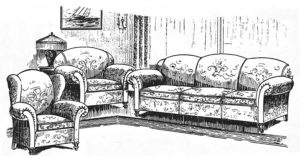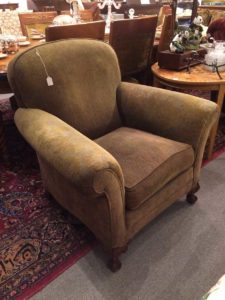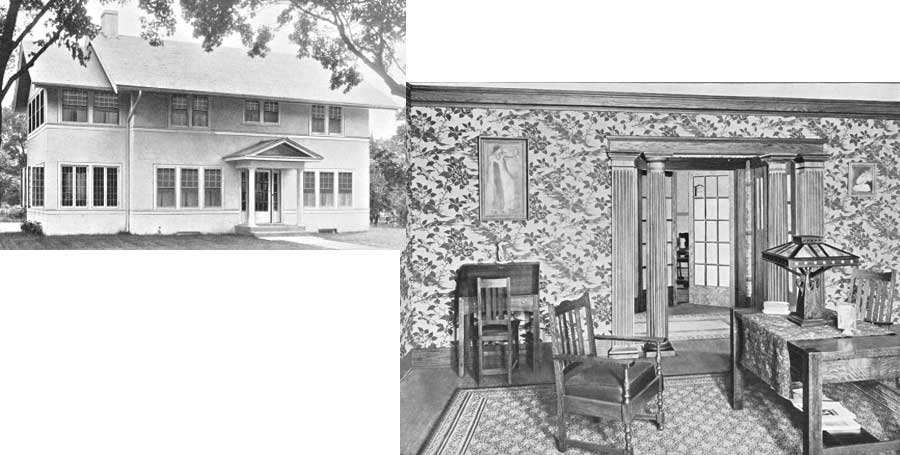Small Home Gazette, Spring 2015
Mission Overload?
Alternative furniture styles were plentiful during the bungalow era
Though I’ve lived with them for almost 20 years, I still enjoy the pieces of Mission furniture in my bungalow’s living and dining rooms. There’s something about the angularity of American Mission that stands out, in a good way, from the curves, curls and cabrioles of virtually every other furniture style throughout history.
But Mission wasn’t the only furniture found in our bungalows when they were new. In fact, I’d say it was rare to find a Twin Cities bungalow completely outfitted with Mission, and that many—if not most—contained (gasp!) no Mission furniture at all.
 After initially wanting to furnish my bungalow entirely with Mission furniture, I eased up. I think I first balked when it came to a sofa. Those Stickley settles look handsome but can be a challenge to settle into comfortably. I soon began to notice and appreciate other early 20th century furniture pieces I found in shops, and it was usually cheaper than Mission furniture. In this article, we’ll focus on furniture that would have originally been found in bungalow living rooms.
After initially wanting to furnish my bungalow entirely with Mission furniture, I eased up. I think I first balked when it came to a sofa. Those Stickley settles look handsome but can be a challenge to settle into comfortably. I soon began to notice and appreciate other early 20th century furniture pieces I found in shops, and it was usually cheaper than Mission furniture. In this article, we’ll focus on furniture that would have originally been found in bungalow living rooms.
Comfortable Colonial
Even during its heyday, Mission was not the dominant style. It was fresh, edgy, artsy, and not universally loved. And the original American Arts & Crafts era had ended by 1915, at least among trendsetters on the east and west coasts. But the style lingered well beyond 1915 in the upper Midwest, as is evidenced by the scores of bungalows with Arts & Crafts interiors built well into the 1920s.
So if it wasn’t Mission that filled our bungalows, what kind of furniture was it? Colonial Revival was the prevailing trend in both furniture and light fixtures. Of course, it’s hard to pinpoint exactly what the Colonial Revival style looked like, as the label seems to have been applied to a wide range of items with vaguely historic details. In publications of the era, available furniture was also described as Chippendale, Elizabethan, English, Federal, Heppelwhite, Italian, and Sheraton. But in everyday books and magazines that dispensed decorating tips to housewives, the recommended furniture was often presented simply as being “in good taste,” or as having”excellent lines.”
Living Room
Below are some example images of early 20th century living room furniture, gleaned from nineteen-teens and ‘twenties publications. While these publications also pictured the occasional room filled with Arts & Crafts furniture, the vast majority of them did not.
The type of furniture you see here is still available in antiques shops and is often quite affordable. Like any old furniture, it often needs repair, refinishing or reupholstering. Although it is becoming rare, occasionally you’ll encounter an overstuffed sofa or chair with its original upholstery that’s still in usable condition—some of those fabrics were of very high quality.

We recently spotted the chair below at H&B Gallery (handbgallery.com) on Hennepin Avenue in Minneapolis. It’s a new piece that was clearly patterned after early 20th century furniture. It was priced $300.
You can also find new furniture that resembles these pieces. We looked, but couldn’t find a particular contemporary company that specializes in reproducing this era’s look. But hunt around—like clothing, most new furniture is based on classic styles that are continually being reinterpreted and reintroduced.
The six pairs of images that follow are from Better Built Homes, a house plan catalog published by Curtis Lumber & Millwork Co., in Clinton, Iowa, in 1919. Each pair of images will show you the house and one of its rooms.
1. Note the room’s strong Arts & Crafts woodwork, yet the furniture is not. The library table and chair at right are what was commonly referred to as "colonial" furniture. Note the Queen Anne Revival chairs in the dining room in the background.
2. The room is in a bungalow, but there’s no hint of Mission furniture. How would leather club chairs look in your living room?
3. Again, note the room’s oak Arts & Crafts woodwork. This image features several furniture pieces with barley twist legs, very popular during the bungalow era. The design was used widely in England in the late 1600s and early 1700s. The rocking chair at left blends Mission elements and barley twist legs.
4. This image shows classic upholstered furniture and an Elizabethan style sofa table.
5. The chair at left has a caned back, a furniture feature that was quite popular in the nineteen-teens and ‘twenties. Note the library table with a weighty Empire base. The ceiling light fixture with a suspended pan was a common style during the bungalow era, much more so than Mission light fixtures.
6. And, as if to prove that absolutely anything goes, the 1919 Curtis Lumber & Millwork catalog included this image. A suite of Arts & Crafts furniture is arranged in a room outfitted with classical Doric columns and wildly floral wallpaper.
The images below are from a 1923 supplement to Womens Weekly magazine on furnishing the home. The top sofa in the right image was described as a “Bed Davenport.”
The sofas and chairs below are from a 1927 catalog published by the Stevens Wholesale Furniture Company in Aurora, Ill.
These items were typically upholstered in velvet or, more expensively, mohair, in deep reds, greens, browns and blues. One can occasionally find vintage pieces like these with still-usable upholstery, though most require recovering. Note the frequent use of patterned seat cushions combined with solid color fabric on the rest of the piece.




















